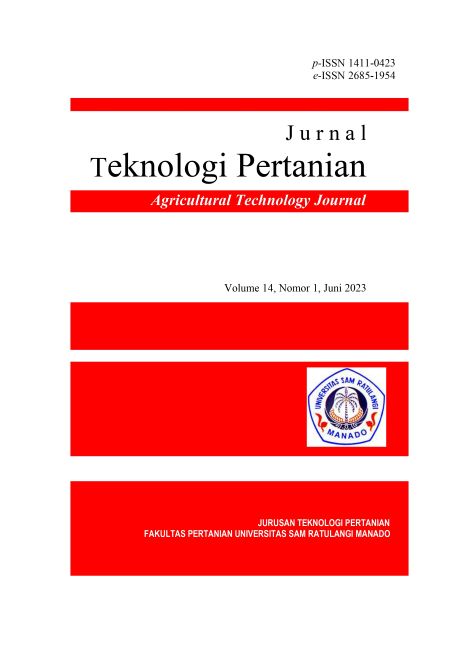Effect Of Blanching on The Physicochemical Characteristic of Leilem Leaves (Clerodendrum Minahassae Teisjm. & Binn).
DOI:
https://doi.org/10.35791/jteta.v14i1.48345Keywords:
dipped-blanching, leilem leaves, chlorophyll, vitamin C, antioxidant activityAbstract
Leilem leaves are vegetables that have a short shelf life, so they require postharvest handling to maintain the quality and quantity of leilem leaves. Blanching can be done as an effort to handle postharvest vegetables which can extend the shelf life of vegetables by heating methods. This research was conducted to determine the effect of blanching time on the quality and nutritional value of leilem leaves. The study was based on the RAL method with 5 treatments namely K0 (without blanching), K1 (1 minute blanching), K2 (3 min blanching), K3 (5 min blanching), K4 (7 min blanching) at 85°C which included a test color (hunter method), water content (AOAC method), chlorophyll content (Wintermans & de Mots method), vitamin C content and antioxidant activity using the spectrophotometer method.
The results showed that there was an effect of the dip blanching treatment on vegetable color, chlorophyll levels, vitamin C levels and antioxidant activity. Blanching at 85°C for 3 minutes increased the water content, chlorophyll content and antioxidant activity, but not vitamin C. A longer blanching time of more than 3 minutes could cause degradation and decomposition of the chlorophyll content and antioxidant activity of leilem leaves.
Keywords: Blanching, Leilem leaves, Color, Chlorphyl, Vitamin C, Antioxidants and Moisture Content
References
Dinar, L., Suyantohadi, A., & M. A. F. Fallah. 2012. Pendugaan Kelas Mutu Berdasarkan Analisa Warna Bentuk Biji Pala (Myristica Fragrans Houtt) Menggunakan Teknologi Pengolahan Citra Dan Jaringan Saraf Tiruan. Jurnal Keteknikan Pertanian. 26 (1) :53-59.
Indrasti, D., Andarwulan, N., Purnomo, E.H., Wulandari, N. 2019. Klorofil Daun Suji: Potensi dan Tantangan Pengembangan Pewarna Hijau Alami. Jurnal Ilmu Pertanian Indonesia (JIPI). Vol 24 (2): 109-116.
Junior, B.D. 2017. Effect of Blansir on Food Bioactive Compounds. Dalam: Reis, F.R. (ed). New Perspective on Food lansing. Springer International Publishing AG. Jacarezinho, Paraná, Brazil
Kurniawati, E., Riandini, H.M. 2019. Analisis Kadar Vitamin C Pada Daging Buah Kelengkeng (Dimocarpus longan L.) Segar dan Daging Buah Kelengkeng dengan Metode Spektrofotomtri UV-Vis. J-HESTECH. Vol 2(2): 119-126.
Laga, A. L. Budyghifari, N. K. Sukendar, & Muhpidah. 2021. Efektifitas Lama dan Metode Blansir terhadap Kadar Antosianin dan Aktivitas Antioksidan Ubi Jalar Ungu (Ipomea batatas L.) Jurnal Mutu Pangan. Vol 8(2): 106-112.
Le, N.L., Le T.T.H, & Ma, N.B. 2021. Effects of Air Temperature and Blanching Pre-Treatment on Phytochemical Content, Antioxidant Activity and Enzyme Inhibition Activities of Thai Basil Leaves (Ocimum basilicum var. thyrsiflorum). Food Research. Vol 5(1): 337-342.
Molyneux, Philip. 2004. The Use of the Stable Free Radical Diphenylpicrylhydrazil (DPPH) for estimating antioxidant activity. Songklanakarin J. Sci Technol. Vol 26(2): 212-219.
Muntikah, M., & R. Maryam. 2017. Ilmu Teknologi Pangan. Edisi ke 1. Badan Pengembangan dan Pemberdayaan Sumber Daya Manusia Kesehatan
Nguyen T. V.L, T.V., Vo, T.D. Lam dan L.G., Bach. 2019. Water Blansir Conditions on The Quality of Green Asparagus Butt Segment (Asparagus officinalis L.) Materials Today: Proceedings. Vol 8(2019): 4799-4809.
Rahmatia, R. A. 2018. Uji Aktivitas Antioksidan Ekstrak Etanol Daun Sisik Naga (Drymoglossum piloselloides L. Pres) dengan Metode DPPH (1,1-Diphenyl-2-picryhydrazyl). Doctoral dissertation, Poltekkes Kemenkes Kupang.
Rahmawati, A. Muflihunna, & Sarif L. M. 2016. Analisis Aktivitas Antioksidan Produk Sirup Buah Mengkudu (Moringa citrifolia L.) dengan Metode DPPH. Jurnal Fitofarmaka Indonesia. Vol 2(2): 97-101.
Reis, F. R. 2017. Effect of Blansir on Food Physical, Chemical, and Sensory Quality. New Perspectives on Food Blanching. Spinger International Publishing. pp. 7-48.
Rispita D. 2018. Aktivitas Antioksidan Ekstrak N-heksana, Etilasetat dan Etanol dari Daun Afrika (Vernonia amygdalina Del.) Secara In Vitro. Fakultas Farmasi, Universitas Sumatera Utara, Medan.
Saidi, I. A., R. Azara & E. Yanti. 2021. Buku Ajar Pascapanen dan Pengolahan Sayuran Daun. Edisi ke-1, UMSIDA PRESS. Sidoarjo, Jawa Timur.
Sari, K. W. 2005. Studi Kemampuan Pengikatan Kolesterol oleh Ekstrak Daun Suji (Pleomele angustifolia N. E. Brown) dalam Simulasi Sistem Pencernaan in Vitro. Skripsi. Fakulats Pertanian, Institut Pertaniann Bogor, Bogor.
Shrivastava, N., & T. Patel. 2007. Clerondendrum and Heathcare: An Overview. Medicinal and Aromatic Plant Science and Biotechnology. Vol 1(1): 142-150.
Solikhah, R., E. Purwantoyo, & Rudyatmi, E. 2019. Aktivitas Antioksdian dan Kadar Klorofil Kultivar Singkong di Daerah Wonosobo. Life Science. Vol 8(1):86-95.
Suyitno. 2010. Deterinasi Pigmen dan Pengukuran Kandungan Klorofil Daun. Prosiding Pelatihan Guru–guru Biologi RSBI DIY. Yogyakarta, 7 Agustus 2010.
Wening, D.K. 2020. The Best Solvent for Extraction of Papaya Leaves (Carica Papaya linn) to get a High Antioxidant. Jurnal Ilmiah Gizi Kesehatan (JIGK). Vol 1(02): 10-14.
Wuisan, R. S. G. 2022. Pengaruh Penambahan Tepung Daun Gedi (Abelmoschus Manihot L.) Terhadap Kandungan Serat Pangan, Warna dan Sensoris Kue Bangkit. Skripsi. Jurusan Teknologi Pertanian, Fakultas Pertanian, Universitas Sam Ratulangi, Manado.
Zhan, X., Z. Zhu, & D. W. Sun. 2019. Effects of Pretreatments on Quality Attributes of Long-term Vegetables: a review. Critical Reviews in Food Science and Nutrion. Vol 59(5): 743-757.
Downloads
Published
Issue
Section
License
Copyright (c) 2023 Gloria Kusmin, Maria F. Sumual, Lana E. Lalujan

This work is licensed under a Creative Commons Attribution-NonCommercial 4.0 International License.


 Journal Template
Journal Template


